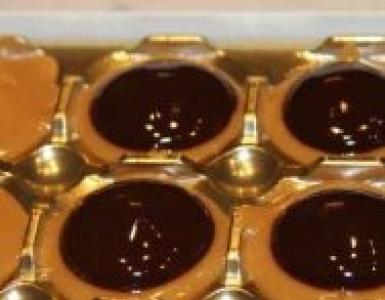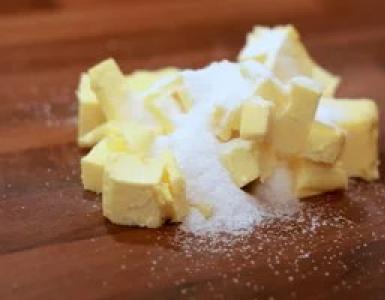Shortbread dough. Shortbread dough Shortbread dough sticks to your hands
Today I want to talk about shortcrust pastry. It really is the basis of many desserts. In fact, if you have a proven shortcrust pastry recipe in stock, you can already come up with a lot of options for using it. Shortbread? - No problem! Tartines with fresh berries, custard, chocolate mousse; Cheesecake base...Continue?
Shortbread dough is perhaps the most tender and crumbly of all. This is exactly what “melts in your mouth.” This is primarily due to the high oil content. Butter prevents the development of gluten in the flour, which gives this dough its characteristic crumbliness. But I know many people have this problem - shortcrust pastry cakes and cookies turn out hard. Why? Now I will try to tell and explain everything to you. To help you make the most tender shortcrust pastry.
Your failures may be due to the fact that you immediately combine all the ingredients together and knead them for a long time. And also, I suspect, you are overdoing it with flour. In this case, you naturally get a “sole”. But shortbread dough requires a more careful attitude.
For example, I prefer to knead shortbread dough by hand. It takes exactly the same amount of time as if I were using a combine. But your hands feel the dough better, and it is impossible to “knead” it. But if you are used to using a food processor or mixer, you can continue - just be very careful here. Once you have added the flour, turn on the processor only in manual mode and no more than 2-3 pulses - stop as soon as all the ingredients are combined. Otherwise the dough will be tough!
The standard shortcrust pastry formula is as follows:
250 g flour
200 g butter - cut into pieces and bring to room temperature
100 g fine sugar, or better yet, powdered sugar
2 yolks (for an even more tender dough) or 1 whole egg
A pinch of salt.
Here we need to make a reservation. I have come across recipes for shortcrust pastry in different sources with different butter contents - from 60 to 80% to flour, such as in the formula above. I baked the cookies you see in the picture using this formula. I can tell you from experience that the more butter you add, the more crumbly and fragile your dough will be. Now I’m not talking about the fact that it will be difficult to roll out - not at all, it rolls out perfectly in any case. I mean already baked.
If you like a firmer product, simply reduce the amount of butter to 150g.
And further. Buy the best butter you can afford - without fragrances or flavors. Still, the taste of butter is seriously noticeable in the shortbread dough.
 But let's get back to the process. Combine soft butter, sugar and a pinch of salt and mix to a paste-like consistency.
But let's get back to the process. Combine soft butter, sugar and a pinch of salt and mix to a paste-like consistency.
 Here you don’t need to beat the butter too much or saturate it with air, so if you use a mixer, it’s important to stop in time.
Here you don’t need to beat the butter too much or saturate it with air, so if you use a mixer, it’s important to stop in time.
 Then stir in the egg or yolks.
Then stir in the egg or yolks.
 Sift the flour onto the table and, as usual, make a well in the center. Place this butter mixture in the center of the flour, and slowly start adding flour from the edges, kneading in a circular motion... (or turn on the processor a couple of revolutionsJ).
Sift the flour onto the table and, as usual, make a well in the center. Place this butter mixture in the center of the flour, and slowly start adding flour from the edges, kneading in a circular motion... (or turn on the processor a couple of revolutionsJ).
 When all the ingredients are combined,
When all the ingredients are combined,
 knead the dough 3-4 times with your hand (no more!) as if rubbing it on the table.
knead the dough 3-4 times with your hand (no more!) as if rubbing it on the table.

As a result, you will end up with a soft paste-like dough. You may even think that it would not hurt to add more flour. Stop! Do not do that. We will put the kneaded dough in the refrigerator (at least half an hour) - and certain processes will also take place there - the gluten of the flour will get stronger, and you can easily roll out your dough, even if you doubt it now.
 Shortbread dough is usually baked at a temperature of 180-200 C - until a sure brown crust, as usual J. It usually takes me no more than 10 minutes. If you don’t want a crust, bake at 170 C - there should be no problems here.
Shortbread dough is usually baked at a temperature of 180-200 C - until a sure brown crust, as usual J. It usually takes me no more than 10 minutes. If you don’t want a crust, bake at 170 C - there should be no problems here.
Wrapped in film, shortbread dough will keep well in the refrigerator for a week. But I advise you to immediately make a double amount - it will last in the freezer for another 3 months...
Now, if you read everything to the end, you are entitled to a bonus! By adding several ingredients to the basic shortcrust pastry formula, we get completely different taste sensations.
For the chocolate shortcrust pastry- replace 30 g of cocoa flour (this is 2 tbsp) - sift cocoa with flour and continue kneading as usual.
For the nut shortbread dough- add finely ground nuts to the butter and sugar mixture - from half to a whole glass (to taste). Only in this case, increase the amount of sugar by a couple of tablespoons to balance the taste. Then add the eggs and continue as usual. Almonds are ideal for nuts, but you can experiment with walnuts, hazelnuts...
And- flavor your dough with lemon or orange zest, vanilla extract, natural vanilla seeds, or any other spices to taste. For the specified amount of dough, 1 teaspoon of spices will be enough - add them at the stage of mixing butter and sugar (this way the spices will be better distributed).
In general, you get the idea - no need to chase recipes - knowing the basic formula of shortcrust pastry and the cooking method, you can radically change the taste of your cookies and tartines. Improvise more! Good luck!
Dough. It would seem that it could be simpler! Flour, water, mix and enjoy. But the wonderful thing about the dough is that it is not just flour and water, it is a real work of art, which even for one housewife rarely turns out the same (like borscht).
At the same time, even without any experiments, it is very, very easy to spoil the dough, and then think about what to do with this “sourness”. Master chefs in this collection share four dozen interesting tips on how to prepare the perfect dough and how to save baked goods if something goes wrong.

SPONGE DOUGH
If the whites are not whipping well, there is probably yolk in them. There is only one way to correct the situation - start beating the other whites again, carefully monitoring the moment the yolk separates. Also, egg whites will not whip well if sugar is added too early. In this case, beat the whites in a water bath.
If the biscuit is too dense and the dough does not rise well in the oven, there may be several reasons. Poorly beaten ingredients and too much flour usually lead to such a sad result. In addition, you should not keep the biscuit dough for a long time before moving it into the oven. Make sure the oven is well heated before you put the dough in it.
In order for the biscuit to bake well, it must be baked at medium temperature. If the baking temperature is too high or too low, the biscuit will turn out unsuccessful, most likely half-baked.
If the sponge cake is difficult to remove from the mold, it is quite possible that the problem is an old and uneven mold. Don't forget to thoroughly grease the pan with butter and sprinkle flour on top. If there is too much sugar in the dough, the sponge cake will also have difficulty releasing from the pan. Follow the recipe carefully, and you will have much fewer problems with baking!
If the sponge cake settles after you take it out of the oven, it means it is not baked. Check with a match that the cake is ready before you take it out! Also, the sponge cake may settle while still in the oven if it is baked at too high a temperature.
To prevent the biscuit from crumbling, cut it with a very sharp knife.
Cool the biscuit at room temperature, and only then remove it from the mold. It will be easier for you to remove the sponge cake, as well as the cake from any other dough, if you place the mold, just removed from the oven, on a wet cloth. Once the mold has cooled, the product will come off easily!

CAKE BOUGH
If the dough separates when adding eggs, there may be too many eggs. Make sure that the butter and eggs you mix are at the same temperature. Continue beating the dough until it reaches the desired consistency.
If the cake does not rise in the oven, the butter and sugar are most likely not creamed well. Another option: the butter melted while kneading the dough.
If the cake is dense and sticky, there is too much flour or liquid. Eggs with sugar, not beaten, but simply mixed into the dough, also give this effect.
Puff Chopped Dough
If the butter and flour crumbs stick together, put the dough in the refrigerator - the butter will cool down and nothing will stick together.
If the dough is too sticky, add a little flour to it and put it in the refrigerator for a while.
If the dough crumbles, this indicates a lack of liquid. Add one teaspoon of water at a time, gently moistening dry areas.
If the products are dry and hard, they have been baked for too long. Watch the time and ensure that the butter does not melt while kneading the dough!
CREATIVE DOUGH
If the dough is too soft and sticky, you most likely used wet cottage cheese. Add flour or semolina to correct the situation.
If the dough crumbles, there is not enough liquid.

SHORT DOUGH
If the dough is too soft, you need to add more flour.
If the dough crumbles, there may be several reasons. Lack of oil, not enough liquid and too cold oil are what ruin shortcrust pastry. Remember to bring the oil to room temperature before kneading the dough!
If the liquid filling does not thicken, perhaps the baking temperature was too low, there are not enough eggs and starch in the filling, or the product did not have time to cook completely.
If the baking temperature is too high, the liquid filling may curdle.
If the cookies are burnt, carefully remove the burnt layer with a grater, and then sprinkle the cookies with powdered sugar.
If you store pies on a ceramic dish, covering them with a napkin made of natural fabric, they will remain fluffy and fresh longer.
You can cut a crumbly cake perfectly if you heat the knife before cutting by dipping it in boiling water for 1 minute.
If the dough is too stiff but sticks to your hands, use a glass bottle of cold water as a rolling pin. It will roll out beautifully!
You can make a very tasty glaze by melting chocolate candies and mints and mixing them with a few tablespoons of water or milk.
Baking is delicious and beautiful - an affordable pleasure. Even if you bake rarely, do it well. Our tips will certainly help you become a master, and the appearance and taste of the products you bake will be gorgeous.
What to do if shortbread dough doesn't work out? We offer a list of the most common mistakes when preparing baked goods, and ways to correct them.
- Dough too crumbly
- Shortbread dough too rough
Shortbread dough fails: 3+8 mistakes and ways to correct them
Shortbread dough too crumbly
Crumbly shortbread dough is good, but everything is good in moderation; what should you do if the baked goods turn out to be too crumbly?
1. Reduce the amount of fat, butter or margarine, maybe even by half.
2. Add a few tablespoons of sour cream to the shortbread dough.
3. Add a little cottage cheese or curd mass to the shortbread dough - for 200 g of butter or margarine there should be up to 100 g of cottage cheese.
Shortbread dough too rough
If baking from shortcrust pastry turns out too rough, “killed”, check yourself, perhaps you are making one of the following mistakes!
1. Flour quality, if the flour has high gluten content, the shortbread will be rough. To avoid this, part of the flour must be replaced with starch.
2. Too many eggs. Alternatively, you can put only yolks in the shortbread dough, without whites; the more yolks, the more crumbly the baked goods will be.
3. Too much flour.
4. The dough was kneaded for too long; this is in no way acceptable for shortbread dough.
5. The recipe is broken, the proportion of ingredients is incorrect - too little fat, too much sugar, low quality margarine.
6. Unsuitable temperature in the kitchen when preparing shortcrust pastry8, if above 25°C, the oil separates from the total mass of the dough and the products turn out hard and tasteless; the ideal temperature for preparing shortcrust pastry is 15-20°C.
To correct this, you can cool it well, knead it again with cold hands, or, as a last resort, add an extra yolk to the dough.
7. Products are of different thicknesses, this is important for shortbread baking.
8. Overbaked - if shortbread dough sits in the oven beyond the allotted time, even if perfectly kneaded, it will become rough and tasteless.
(Visited 1 times, 1 visits today)













